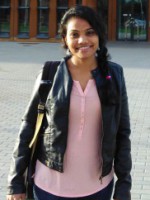resumo
Plasmonic nanostructures concentrate light and heat within a small volume at the nanoscale, offering potential applications in nanotechnology and biomedicine (e.g., hyperthermia). However, the precise quantification of the actual temperature rise in the vicinity of such nanosystems poses considerable challenges. Here, we present a new heater-thermometer nanoplatform capable of measuring the plasmon-induced local temperature increase of Au nanorods via the ratiometric upconversion of (Gd, Yb, Er)(2)O-3 nanothermometers upon 980 nm laser excitation (up to 102.0 Wcm(-2)). The local temperature rise, 302-548 K (maximum temperature sensitivity 1.22% K-1, uncertainty 0.32K and repeatability > 99%), is assessed using Boltzmann's distribution of the Er3+ (2)H1(11/2) -> I-4(15/2)/S-4(3/2) -> I-4(15/2) intensity ratio. The nanoplatforms are biocompatible with MG-63 and A549 cells and were mapped within the former using hyperspectral imaging, opening up an avenue to monitor the cellular uptake of Ln(3+)-based nanoplatforms.
palavras-chave
UP-CONVERSION NANOPARTICLES; PHOTOTHERMAL THERAPY; GOLD NANORODS; ENERGY-TRANSFER; CELL; LUMINESCENCE; NANOSCALE; NANOSTRUCTURES; TEMPERATURE; GENERATION
categoria
Chemistry; Science & Technology - Other Topics; Materials Science
autores
Debasu, ML; Brites, CDS; Balabhadra, S; Oliveira, H; Rocha, J; Carlos, LD
nossos autores
Projectos
CICECO - Aveiro Institute of Materials (UID/CTM/50011/2013)
LUMINET - European Network on Luminescent Materials (LUMINET)
RMNE-UA-National Network of Electron Microscopy (REDE/1509/RME/2005 )
agradecimentos
This work was developed in the scope of the project CICECO-Aveiro Institute of Materials (Ref. No. FCT UID/CTM/50011/2013), financed by national funds through the FCT/MEC and when applicable co-financed by FEDER under the PT2020 Partnership Agreement. Financial support of EC Marie Curie Initial Training Network LUMINET (316906) is also acknowledged. MLD (SFRH/BPD/93884/2013) and CDSB (SFRH/BPD/89003/2012) thank Fundacao para a Ciencia e Tecnologia (Portugal) for the post-doctoral grants. MLD thanks the Colloid Chemistry Group (Vigo) for gaining important insights into the synthesis of oxide-gold nanoplatforms. RNME-Pole University of Aveiro-FCT Project REDE/1509/RME/2005 is acknowledged for access to electron microscopy.







